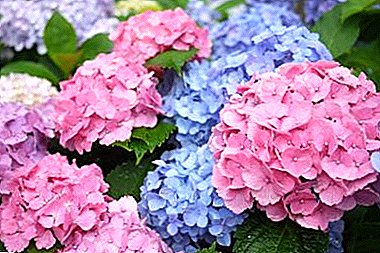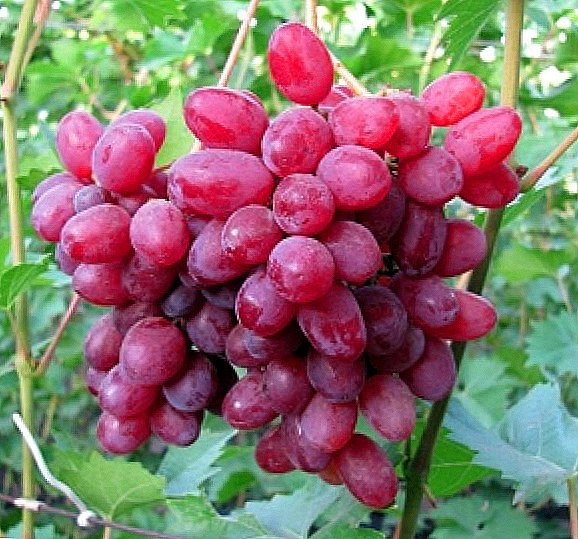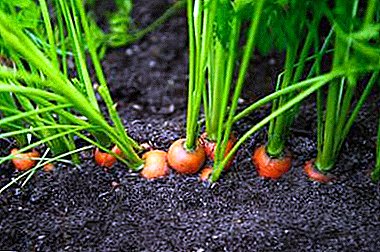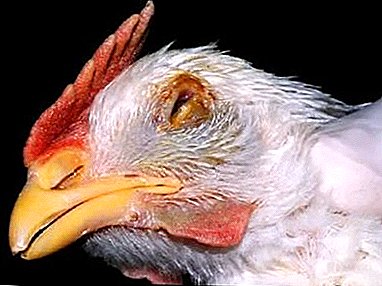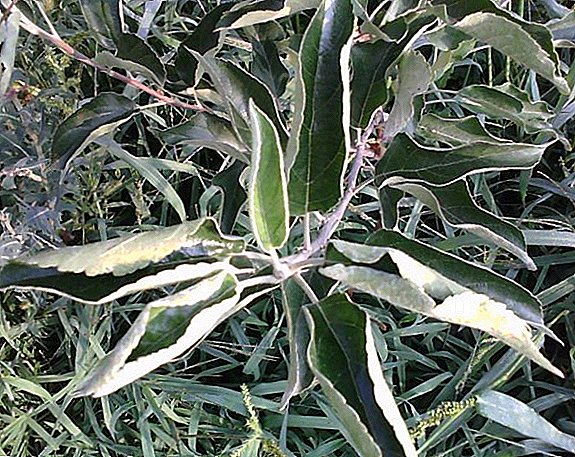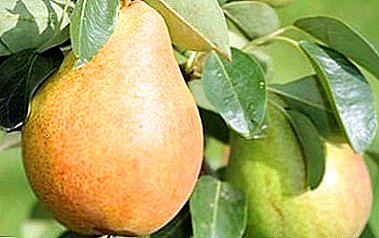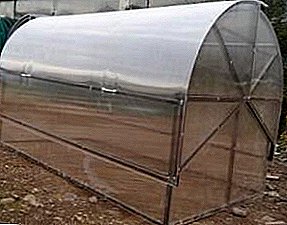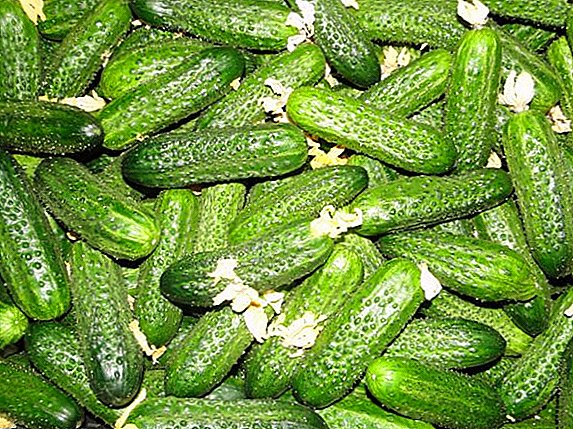 Cucumber - perhaps one of the most beloved vegetable fruits on the planet. Suitable for use raw, as part of various salads, and for pickling, pickling and preserving. Zelentsy can please the eye throughout the summer. Breeders bred a lot of different varieties, which eliminated some of the characteristic culture deficiencies and implemented some useful qualities. One of these hybrids is the Berendey F1 variety.
Cucumber - perhaps one of the most beloved vegetable fruits on the planet. Suitable for use raw, as part of various salads, and for pickling, pickling and preserving. Zelentsy can please the eye throughout the summer. Breeders bred a lot of different varieties, which eliminated some of the characteristic culture deficiencies and implemented some useful qualities. One of these hybrids is the Berendey F1 variety.
Variety description
Cucumbers "Berendey" belong to the early ripening varieties. Blossom mainly female type of flowering. Average lash whip moderately branched. The foliage is green, medium size. The node contains at least 3 ovaries. 
Among the features of this variety are the following:
- excellent taste;
- versatility, suitable for both salting and raw eating;
- fruits have a good appearance;
- suitable for growing in a greenhouse, and for open ground;
- there is no need for pollination (parthenocarpic variety);
- the variety is sufficiently resistant to pests and all sorts of diseases;
- possesses high productivity.
Did you know? Botany classifies cucumber as a fruit, treating it as a false berry. In cooking, the fruit is considered a vegetable.
Fruit characteristics and yield
1.5 months after the shoots appear, the first fruits ripen. With proper care and favorable weather conditions from 1 square. garden meter can be collected about 14.5 kg of cucumbers. The diameter of the fruit can reach 45 mm, the length of the fruit - up to 14 cm, the average weight - 140 g. The shape of the cucumber is correct, on the surface there are clearly visible tubercles with light spikes.
Check out such early ripening cucumber varieties as: "Siberian Festoon", "Taganay", "Competitor", "Zozulya", "Finger", and "Courage".
Green, almost emerald peel has a rather delicate structure. The flesh is juicy and sweet, with a bite produces a distinct crunch. Pronounced aroma characteristic of this vegetable. The grade perfectly is suitable both for the use in the raw, and for preservation (salting). 
Selection of seedlings
If for some reason you have not grown seedlings yourself, you will have to purchase it on the market. Doing this is better, of course, from a familiar manufacturer, whose reputation you know. But if this is not possible, you will have to deal with an unfamiliar seller. In such cases, talk to the manufacturer. Ask him about the variety he deals with. If a person confidently answers your questions, knows a lot about this type, then you can probably deal with it.
We recommend to get acquainted with unusual varieties of cucumbers.
Now you can go to a visual inspection of the seedlings, its choice should be guided by the following rules:
- seedling age should not exceed 1 month;
- the stem should be healthy and thick enough, with no signs of dryness;
- carefully examine the root system (it is rather weak in cucumbers), it should look healthy, be in the ground and have no signs of dryness;
- on one seedling should be no more than 4 leaves of dark green color;
- the height of one shoot should not exceed 12-15 cm;
- carefully inspect the lower leaves, they should not be wilted and yellowed (such leaves may indicate excessive use of growth promoters);
- It is desirable that the seedlings were in the ground and were sufficiently moist.

Important! In early cucumber varieties, female inflorescences are formed on the main stem; for this reason, these varieties are not pinned.
Soil and fertilizer
Cucumbers are very demanding on the composition of the soil, so if you want to grow a normal crop, you should worry about preparing the beds for planting in advance. All cucumbers, and "Berendey" in particular, love loam or loose sandy loam. Soils with a high level of acidity, as well as heavy soils, are not suitable for normal growth of this vegetable. The pH should be neutral or weak acidity.
Learn how to feed cucumbers after planting, in a greenhouse, during flowering, as well as how to feed yeast, iodine, and increase the crop with green manure.
So the first thing is to determine the level of acidity of the soil. PH 7 is considered normal, lower values are an indicator of greater acidity. The lower the pH, the less suitable the soil is for growing the crop. However, it cannot be said that Berendey is suitable for high pH (alkaline soil type). As already mentioned, it is desirable that the indicator be close to pH 7.  Soil analysis for acidity. To determine the acidity, you can contact the laboratory, or you can purchase the Alyamovsky device, and carry out the analysis yourself, following the instructions. It is easier and more accessible to analyze soil for acidity using indicator paper (litmus). This indicator is sold in stores of chemical reagents.
Soil analysis for acidity. To determine the acidity, you can contact the laboratory, or you can purchase the Alyamovsky device, and carry out the analysis yourself, following the instructions. It is easier and more accessible to analyze soil for acidity using indicator paper (litmus). This indicator is sold in stores of chemical reagents.
Read also about how to determine the acidity of the soil, pick up fertilizer and deoxidize.
This analysis should be done as follows:
- cut the ground to a depth of 0.3 m with a bayonet spade;
- take a handful of earth, moisten it with distilled water, mix well;
- In the middle of the resulting pellet insert a strip of the indicator, hold for 1 minute;
- remove the strip and compare its color with the control scale;
- the appropriate color will indicate the pH level of your soil.
 Dolomite flour.
Dolomite flour.Neutralize excess acid such substances:
- lime;
- dolomite flour;
- cement dust;
- a piece of chalk;
- wood ash.
Did you know? The homeland of the cucumber, known to mankind already in the IV millennium BC. e., are subtropical areas of the Indian subcontinent. In the foothills of Tibet, this culture can still be found in its wild form. In the Bible, it is known as an Egyptian vegetable.
Growing conditions
When growing cucumbers of the Berendey variety, it is necessary to follow some simple rules:
- the variety loves light soils with a high level of humus;
- planted in the same place no earlier than after 4 years;
- grows best after tomatoes, peas, corn and early potatoes;
- bad sprout after all the pumpkin;
- soil temperature not lower than +14 ° С;
- recommended air temperature is + 24… + 30 ° С;
- the soil should be well hydrated;
- good potash supplement is needed;
- sufficient level of CO2 in the air;
- the place should be well lit, while it is necessary to avoid direct sunlight on the plants, they can burn the delicate cucumber leaves.

Growing from seed to seedlings at home
The most common method of growing cucumbers - planting seedlings in open ground. With this method, an already grown (about 1 month) plant is planted in the soil, which begins to bear fruit sooner than the seed planted directly into the ground.
We grow cucumbers in open ground, in a greenhouse, on a balcony, on a windowsill in winter, in buckets, in a barrel and in bags.
Self-cultivation of seedlings is preferable to the use of the purchase. You yourself know, from the seeds of what quality seedlings are grown, do not use in large quantities various growth stimulants. Carry out the necessary hardening, maintain the desired level of soil moisture.
Seed preparation
Before you start preparing the seeds for planting, pick out the empty seeds. To do this, dissolve in a glass of water 1 tsp. salt and dip the seeds into the water. Those seeds that remain on the surface can be thrown away - they are empty. Collect the remaining seeds, they passed to the next stage of preparation.  If you purchased seeds of a well-known brand in the package, they do not need preprocessing. They have already been treated with antiseptic and growth stimulants. If you bought seeds or use your own, then they should be processed before planting. Suitable for this purpose:
If you purchased seeds of a well-known brand in the package, they do not need preprocessing. They have already been treated with antiseptic and growth stimulants. If you bought seeds or use your own, then they should be processed before planting. Suitable for this purpose:
- soaking in 1% potassium permanganate solution for 20 minutes;
- soaking in 0.5% baking soda solution for 1 day. Such a procedure, in addition to disinfection, has the effect of stimulating germination;
- phytosporin solution.
Important! Horse manure for feeding cucumbers is contraindicated due to the high ammonia content.
Now it is necessary to germinate planting material. This should be done as follows:
- Thoroughly moisten a small thick napkin with water (a good option is a kitchen terry cloth 30x30 cm).
- Put the napkin in a wide shallow plate so that half of the napkin is on the plate, and the second half hangs loose. Pour some water into the bottom so that the wipe is sufficiently wet, but there is no water at the bottom of the plate.
- Put the seeds on a napkin, cover the top with the part that hangs loose.
- From above tighten a plate a film, it will create a necessary microclimate.
- Periodically remove the film for a while, after a few days green sprouts will erupt from the seeds. They can be planted in the soil upon reaching a length of 7-10 mm (approximately 4-6 days).

Content and location
Depending on the number of seeds, you can use an individual container for each seed (disposable cups with drainage holes, peat pots) or a common seed container, designed for several seeds (egg trays, plastic strawberry boxes, etc.). In that case, if you use the total capacity, when the seedlings reach 5-6 cm (after the appearance of two true leaves), they will have to be transplanted in individual capacities.
Choose the right capacity for seedlings.
Seating tanks should be placed on a light and warm enough sill. Light seedlings is extremely necessary, as well as heat. In the event that there is not enough heat, you will have to use an additional source of heating (lamps, heaters).
Seed planting process
To plant seeds for seedlings in the south of Russia and throughout Ukraine begin around April. More precisely, the date of sowing seeds can be calculated based on weather conditions. Cucumbers should be planted in open ground, when the earth warms to +12 ° C to a depth of 0.1 m. The average daily temperature by this time should be +20 ° C and higher, and the nighttime temperature should not fall below + 14 ... +16 ° C .  From the first days that meet these weather conditions, subtract 4 weeks. This will be the recommended date of sowing seedlings. A few days before planting seeds, it is necessary to fill the prepared soil into the container for seedlings, having previously laid drainage on the bottom (expanded clay, polystyrene foam).
From the first days that meet these weather conditions, subtract 4 weeks. This will be the recommended date of sowing seedlings. A few days before planting seeds, it is necessary to fill the prepared soil into the container for seedlings, having previously laid drainage on the bottom (expanded clay, polystyrene foam).
You can buy a special primer in the store, and you can prepare yourself:
- turf soil - 2/5 parts;
- peat - 2/5;
- sawdust - 1/10;
- manure - 1/10.
Or such a composition:
- rotted manure - 3/5 parts;
- turf ground - 3/10;
- sand - 1/10.
Did you know? From the ancient Greeks, the cucumber migrated to the Romans, from which approximately in the VIII-IX centuries began to quickly conquer Europe. German Ambassador Herberstein in his "Notes about the journey to Muscovy" for the first time mentions a cucumber in the territory of the future Russian Empire in 1528.The soil must be calcined in the oven at + 180 ° C for 20 minutes or shed with 2% potassium permanganate solution at a temperature of 100 ° C (boiling water).
Now it is necessary to introduce fertilizer into the soil per 10 l of the mixture:
- superphosphate - 15 g;
- potassium sulfate - 8 g;
- urea - 7 g;
- magnesium sulfate - 2 g
 Superphosphate. The soil in the seedling containers should be sufficiently moistened, but excess moisture is undesirable. Fill containers with 4/5 of volume 4-5 days before planting, during this time achieve the required level of moisture (watering the ground or placing containers on the battery to evaporate excess moisture). When the seeds and soil are ready, you can start planting. If you are using individual containers, make your finger grooves in the soil with a depth of 0.5 cm.
Superphosphate. The soil in the seedling containers should be sufficiently moistened, but excess moisture is undesirable. Fill containers with 4/5 of volume 4-5 days before planting, during this time achieve the required level of moisture (watering the ground or placing containers on the battery to evaporate excess moisture). When the seeds and soil are ready, you can start planting. If you are using individual containers, make your finger grooves in the soil with a depth of 0.5 cm.  In the resulting groove, place a seed and sprinkle with a layer of earth so that there is a layer of soil about 1 cm thick above the seed. In case you use a common tray for several seeds, make longitudinal grooves in the ground. Place the seeds in them every 6-7 cm, sprinkle the grooves with the soil in the same layer as in the previous method. This method is worse than individual planting in that the shoots will soon have to be transplanted.
In the resulting groove, place a seed and sprinkle with a layer of earth so that there is a layer of soil about 1 cm thick above the seed. In case you use a common tray for several seeds, make longitudinal grooves in the ground. Place the seeds in them every 6-7 cm, sprinkle the grooves with the soil in the same layer as in the previous method. This method is worse than individual planting in that the shoots will soon have to be transplanted.
Seedling care
In the care of cucumber seedlings, first of all, 3 components should be controlled:
- temperature;
- watering;
- lighting.
For seedlings, a comfortable temperature is + 20 ... +23 ° С. In the event that the upper limit of this range is too high, it is necessary to moisten the soil more and to ventilate the room. In case of lowering the temperature, you can use fitolampa. Such lamps can be purchased in specialized stores. In addition to heat, they provide a lot of light needed for proper growth of seedlings.
Important! In case of insufficient lighting, the saplings are strongly drawn out; it is then inconvenient to plant such seedlings. In addition, it becomes susceptible to various diseases.If it is overcast outside, a 60-watt lamp is suitable for additional lighting. In the case when the weather is sunny, natural light will be sufficient. For watering seedlings need to use only warm water, a temperature of about +25 ° C. Make sure that the soil is moderately moist, but in no case is it flooded (excessive moisture is a threat to the root system).
 If, however, an excess of moisture is observed, put the seedlings in a warm place for the rapid evaporation of moisture and stop watering for a while. If the ground dries up - use a spray. As the seedlings grow, it is necessary to harden. On a windless day, shoot out onto a balcony or open a window. Start with a five-minute procedure, adding to it daily for 3-5 minutes. With the growth of seedlings in the tank is necessary to pour the soil. This procedure should be carried out twice as the seedling grows.
If, however, an excess of moisture is observed, put the seedlings in a warm place for the rapid evaporation of moisture and stop watering for a while. If the ground dries up - use a spray. As the seedlings grow, it is necessary to harden. On a windless day, shoot out onto a balcony or open a window. Start with a five-minute procedure, adding to it daily for 3-5 minutes. With the growth of seedlings in the tank is necessary to pour the soil. This procedure should be carried out twice as the seedling grows.Find out how many days cucumbers sprout.
In addition, seedlings need additional feeding. Feed young growth about 2-3 times. The first time - after the appearance of the first leaflet, after the appearance of the second leaflet - the second feeding. After 2 weeks after the second feeding spend the third. You can purchase store fertilizers for these purposes, and you can cook them yourself. It's easy to do, below is a recipe for fertilizer, perfect for feeding young cucumber sprouts:
- water - 3 l;
- chicken litter - 50 g;
- superphosphates - 4 g;
- ammonium nitrate - 2 g;
- potassium sulfate - 4 g
Did you know? Greenhouses are the same age as our era. The first types of modern greenhouses were invented in ancient Rome. The reason was the emperor Tiberius’s desire to see fresh vegetables on his desk every day.
Transplanting seedlings to ground
When the earth is warm enough and your seedlings are ready, it can be transplanted into the ground. In the event that it is time to plant the seedlings, and the air temperature is still not high enough, reduce watering, this will slow down the growth. If you still decide to plant young seedlings, and the air temperature is not high enough, use a garden film. The approximate time suitable for transplanting cucumbers to the ground is the first decade of June, under the film is the beginning of the second decade of May.  2 weeks before planting cucumbers need to cook a garden bed. Dig grooves with a depth of 0.2-0.25 m in the future bed. Dumped manure should be put on the bottom of the groove, compost can be added, sprinkle the fertilizer with a layer of soil.
2 weeks before planting cucumbers need to cook a garden bed. Dig grooves with a depth of 0.2-0.25 m in the future bed. Dumped manure should be put on the bottom of the groove, compost can be added, sprinkle the fertilizer with a layer of soil.
- Seedlings should be planted in a staggered manner with a pitch of 0.25 m, between rows - 0.6 m. With this method of planting, each plant will receive enough sunlight.
- Before transplanting seedlings on the beds, dig a hole under each seedling, pour it and put compost or manure on the bottom.
- Carefully remove the seedling with soil from the seedling container (if the seedlings are in a peat pot, plant it with it) and place the seedling in the hole.
- Seedlings should be placed in the hole so that the top layer of the substrate is 1-1.5 cm below ground level.Then sprinkle the plant with soil and lightly tamp hands.
- Water the seedlings with warm water and cover the root system with straw. This measure will create an additional microclimate (evaporation of moisture will slow down and for some time a high temperature will be maintained in the near-root area).
Important! Transplant cucumber seedlings carried out, guided by some rules. Stalk seedlings can not be strongly buried in the ground. Cucumber beds should be loosened. Spud plant should not, otherwise it will die. This culture requires regular and fairly frequent watering.
Agrotechnics growing seeds in open ground
The spreading method of cucumber cultivation is quite common. With this method, the seeds are planted immediately in the wells, on an open garden bed or in a greenhouse.
Make high beds at the cottage and make fences.
Outdoor conditions
For the cultivation of cucumbers "Berendey" in a seedless way fit both greenhouse and open beds. Soil preparation is performed in the same way as for growing seedlings, as described above.  Look at the plot under the beds, mark it and prepare it in the fall. If it failed to do this in the fall, in the spring you can do everything in a simplified way. In the event that the soil is acidic, and in the fall you did not add lime, ash or chalk, you do not need to do this in the spring. It will be enough liquid alkaline organic fertilizers.
Look at the plot under the beds, mark it and prepare it in the fall. If it failed to do this in the fall, in the spring you can do everything in a simplified way. In the event that the soil is acidic, and in the fall you did not add lime, ash or chalk, you do not need to do this in the spring. It will be enough liquid alkaline organic fertilizers.
The process of planting seeds in the ground
Seed should be planted when the soil temperature rises to + 16 ... +18 ° С. In central Russia, this is approximately the second half of May. In the south of Russia and the entire territory of Ukraine - the first decade of May. Before planting, we prepare seeds in the same way as for growing seedlings. Only more attention should be paid to hardening. After disinfection (potassium permanganate or soda), wrap the seeds in a damp napkin and refrigerate for three days.
After that, remove the planting material from the refrigerator and place it for three days in a place with high temperature. It is necessary to prepare a bed for planting seeds in the same way as it is done for the seedling method (add humus, pour boiling water and leave under the film for three days). Make holes 5 cm deep, the distance between the holes - 0, 25 m, row spacing - 0.6 m. Put 3-4 seeds in each well. Subsequently, if several shoots rise, they will need to be thinned out. 
If you want to see a good harvest, follow the simple rules:
- periodically remove the crust on the soil;
- carefully remove the weeds, it is advisable to do it with your hands (the root system of cucumbers is weak and weeding is dangerous for it);
- make tapestries and tie up shoots;
- after each watering, gently loosen the aisles and the soil directly on the beds;
- fertilize the land 1 time in 1.5-2 weeks.
Did you know? Breeders from the UAE brought cucumber cubic shape.
Watering
If the weather is rainy, frequent watering is not required. If the weather is dry, then daily watering should be carried out. It is best to do this with warm (+ 23 ... +25 ° C) rainwater until 9 am in the initial stage of crop growth. And transfer the watering to the evening hours by the time the plant begins to bear fruit.
We recommend reading about how to water cucumbers in the open field and in the greenhouse.
In the event that there are no dogs and the air temperature for the normal growth of cucumbers is not high enough, pour them hot (+ 55 ... +60 ° C) with water just under the shrub, so that moisture does not fall on the leaves. The rate of irrigation - 5-6 liters of water per 1 square. meter every week before flowering. When the plant begins to bloom and bear fruit, watering should be increased to 13-25 liters weekly.  You need to water the culture with a watering can. The use of a hose, and especially tap water, is highly undesirable. You can install drip-type watering made from plastic bottles:
You need to water the culture with a watering can. The use of a hose, and especially tap water, is highly undesirable. You can install drip-type watering made from plastic bottles:
- In the bottle caps with a capacity of 2 liters, 5-7 holes are made with a hot nail, then the cork is wrapped with a rag.
- The bottle's wall is incised around the circumference, at a distance of 3 cm from the bottom, so that the bottom prevents debris from getting into the container, but by bending it, you can pour water into the bottle.
- Next to the cucumber bush, a hole is dug to such a depth (13–15 cm) that the bottle surely holds upside down in it (a cork with holes wound with a rag rests against the bottom of the hole).
Important! Try to test for proper soil moisture. Roll the ball out of a small wad of earth. If you managed to make a ball - the humidity is correct, if it spreads and smears - the soil is too wet, if it crumbles - there is a lack of moisture.
Soil loosening and weeding
Weeding in cucumber rows is carried out no more than five times during the entire growth period, the rows between rows are weeded up to four times. Loosen the soil together with the cultivation and thinning of seedlings. This should be done very carefully so as not to damage the roots of the plants. 
Masking
C reads that varieties with a predominantly female type of flowering, to which Berendey belongs, do not need to be staved. In this case, it may even harm the plant. Passering procedure is necessary in cases where the plant does not bear fruit. In the leafy sinuses appear stepchildren, for the growth of which the plant gives the nutrients necessary for the formation of ovaries.
Find out what to do for the staving of cucumbers.
Garter
Particular attention should be paid to the garter plants. Here are some reasons why a garter should be worn:
- tied cucumbers occupy less space, therefore, it is possible to plant more bushes on the same area;
- garter facilitates harvesting;
- contact with the earth increases the risk of various diseases and the appearance of parasites;
- a larger number of shoots and inflorescences appear on the tied whip, which leads to an increase in yield;
- a bound plant requires less maintenance;
- fruits on tied lashes receive more light, respectively, ripen faster.
 Scheme garter cucumbers. The procedure is carried out after the stem grows to 0.3-0.35 m. By this time, 4-6 full-fledged leaves are growing. It is more expedient to carry out a garter in the morning, before it becomes hot. The basic rules that must be followed when tying the lash:
Scheme garter cucumbers. The procedure is carried out after the stem grows to 0.3-0.35 m. By this time, 4-6 full-fledged leaves are growing. It is more expedient to carry out a garter in the morning, before it becomes hot. The basic rules that must be followed when tying the lash:
- trellis should be installed in advance to avoid damage to the root system;
- to support the scourge, use strips of cloth (width - 3-4 cm), since the ropes injure the stems;
- it is necessary to secure the stem under the first or second leaf;
- when the lash is sufficiently branched, the lateral processes must be tied up separately, otherwise they may braid the parent stem, causing injury to him;
- when the main stem grows into a trellis, it will have to be pinched, otherwise it will continue to grow in length, preventing the lateral shoots from developing.
Did you know? Europeans prefer cucumber varieties with a smooth surface that do not have prickles. Fruits with thorns they call "Russian cucumber".For the manufacture of a trellis you will need two supports of metal or wood, strips of cotton fabric, wire and rope. Before mounting, wooden supports are treated with an anti-bacterial composition or painted, and metal supports are painted with or are subject to anti-corrosion treatment.
There are these types of garters:
- horizontal. Near the plants, two pipes are driven in along the edges of the bed. Between them, at a distance of 0.25–0.3 m, the ropes are tightened, and the ropes will be twisted. Horizontal ropes can be connected to each other vertically every 0.7-1 meters. The design is easy to manufacture, quite effective, but has one drawback: overgrown support stems lean down and shade part of the plant. To eliminate this drawback, you should make higher trellis and do not forget to pinch the plants when they reach the appropriate length;
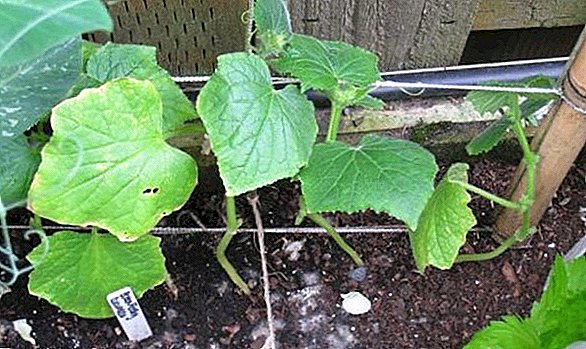
- vertical. The supports are installed in the same way as in the previous method - along the edges of the bed. At the top between the supports, the rope is tensioned, vertical ropes are tied to it according to the number of plants. The top of each lash tied to a vertical rope. As a variant of this method, install an individual vertical column near each plant. The method is good for garter a large number of plants;
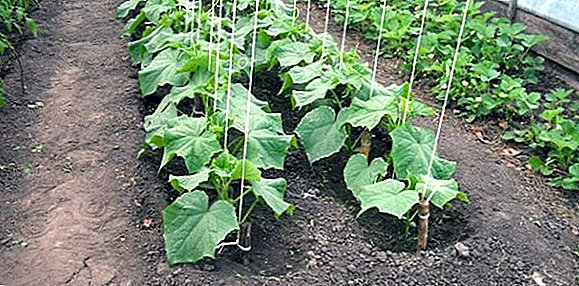
- hybrid. It is used if the plants were planted in a circle. A support is installed in the center, a peg is driven in near each plant. Between the peg and the central support, a rope is stretched over which the whip will twist;

- wall. Between the two supports, located along the edges of the bed, the grid with a large cell is stretched. If the bed is long, in order to avoid mesh sagging, not two supports are used, but more. Between the two extreme supports establish several intermediate. A variant of such a garter is a grid of wire or intersecting wooden slats (garden pergola).

Important! When making a garter, the ropes should not be fixed tightly, tightening the stem. Leave them slightly relaxed.
Top dressing
The first feeding should be carried out after the first shoots appear. Seed-grown seedlings are fed after the appearance of the first two true leaves. From the introduction of the first portion of fertilizer depends on the subsequent feeding schedule. The next time you need to feed the plant in 2-3 weeks after the first time. There is a basal and foliar feeding.
- Radical. Fertilizers are applied as close as possible to the root. Fertilizers are dissolved in water and gently watered in the basal area so that the solution does not get on the leaves.
- Foliar. Spray the plant with a solution of low concentration so as not to burn the leaves. Sometimes these schemes are shared.
Of organic fertilizers, mullein is considered the best for cucumbers. It is dissolved in water (1:10) and the resulting solution fertilizes the soil at the rate of 1 l of funds for one young growth.  Mullein. It is well suited as a fertilizer bird droppings (chicken, pigeon). The solution is prepared in the same proportions as with the use of mullein (1:10), only 2 cups of wood ash should be added to the product obtained. One liter of fertilizer is required per plant.
Mullein. It is well suited as a fertilizer bird droppings (chicken, pigeon). The solution is prepared in the same proportions as with the use of mullein (1:10), only 2 cups of wood ash should be added to the product obtained. One liter of fertilizer is required per plant.  Bird droppings. Top dressing with urea. 50 g of urea is dissolved in 10 liters of water. 0.2-0.25 l of the resulting solution is injected at the root of each plant. You cannot mix urea with superphosphates or lime, otherwise the substances will react and the nitrogen that the plant needs will disintegrate.
Bird droppings. Top dressing with urea. 50 g of urea is dissolved in 10 liters of water. 0.2-0.25 l of the resulting solution is injected at the root of each plant. You cannot mix urea with superphosphates or lime, otherwise the substances will react and the nitrogen that the plant needs will disintegrate.  Urea. Ammofosk. Spread 25-30 g of fertilizer evenly between rows, and then mix it with the soil, slightly digging up the aisles. If the plant is healthy, it should not be fertilized during flowering. Ammofoska helps to reduce the level of nitrates in fruits.
Urea. Ammofosk. Spread 25-30 g of fertilizer evenly between rows, and then mix it with the soil, slightly digging up the aisles. If the plant is healthy, it should not be fertilized during flowering. Ammofoska helps to reduce the level of nitrates in fruits. 
Did you know? In the city of Nezhin, which is located in the Chernihiv region of Ukraine and is famous for its famous pickled cucumbers, a monument to greengrass has been erected.In the event that the fruits grow weakly, have a pale appearance, it is necessary to feed them additionally:
- ammonium nitrate - 20 g;
- superphosphate - 25 g;
- potassium nitrate - 10 g;
- water - 10 l.
Feed each plant 0.25 l of fertilizer during the fruiting period. For foliar application you can use the following means:
- warm water - 10 l;
- superphosphate - 35 g
 Use the obtained product to spray the plants in the morning or in the evening in order to avoid direct sunlight on the foliage. For spraying cucumbers, the following tool is also suitable:
Use the obtained product to spray the plants in the morning or in the evening in order to avoid direct sunlight on the foliage. For spraying cucumbers, the following tool is also suitable:
- boric acid - 5 g;
- potassium permanganate - 0.5-1 g;
- water - 10 l.
During the period of fruiting, feeding of cucumbers increases the number of ovaries, improves fertility and the taste qualities of the vegetable. Cucumbers generally need microelements, especially potassium, magnesium and phosphorus. It is better to combine fertilizing with organic and mineral fertilizers. Another good tool during the fruiting period:
- potassium nitrate - 25 g;
- water - 10 l.
This amount of fertilizer is enough for about 35-40 plants. During the entire fruiting period, a urea solution is used for spraying. After the fertilizers are applied for the third time, you need to feed them at intervals of 2-3 weeks.
Familiarize yourself with the types of mineral fertilizers.
Some folk remedies for feeding cucumbers:
- yeast.This feeding helps the development of the root system, increases the plant immunity, increasing its resistance to various diseases. Dissolve a pack of raw yeast in 2 liters of warm water, add 5 tbsp there. tablespoons of sugar, mix well and put in a warm place. After 1 day, pour the fermented wort into 10 liters of water.
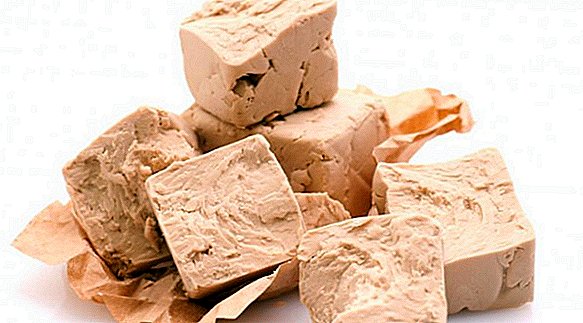
- wood ash. In 10 liters of warm water to dissolve 0.2-0.25 kg of ash. Consumption - 1 liter per plant. Ash is also sprinkled around the bushes for the prevention of disease.
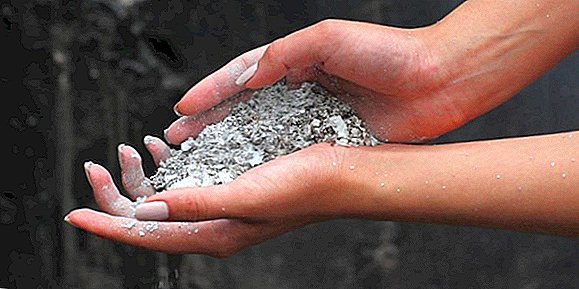
Important! The caloric value of one kilogram of cucumbers is about 150 kcal. This fruit can be considered dietary.
Pests, diseases and prevention
Cucumbers, like other vegetables, are subject to various diseases and pest invasion. Among the characteristic diseases are the following:
- downy mildew (peronosporosis). Mushroom disease of cucumbers, in which yellow spots appear on diseased leaves, gray fungal spores appear on the back of the spots. The disease develops in conditions of high humidity (fogs, dew) and air temperature + 17 ... +23 ° С. The focus of the disease may be plant debris.
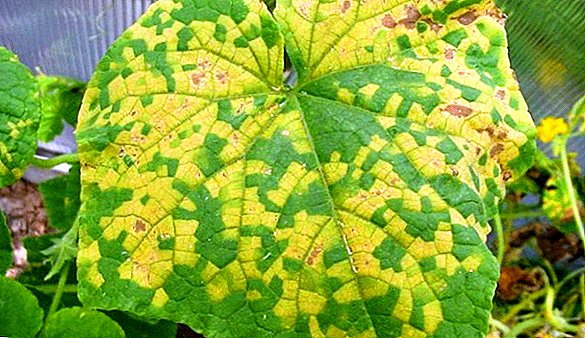
- powdery mildew. Fungal disease, characteristic features of which are white spots, resembling see spilled flour, on the front side of the sheet. This is the mycelium of the causative agent of the disease. Gradually the stain covers the whole sheet.
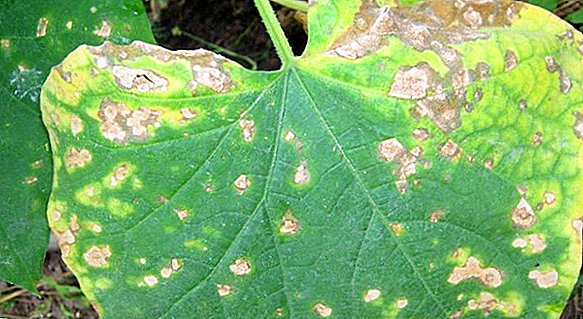
Did you know? July 27 is International Cucumber Day. In Suzdal, Vladimir region, this day for the first time celebrated the Cucumber Festival.
- cladozoriosis (olive brown spot). Fungal disease, most often affecting the fruit, at least - the foliage and stems of plants. In the initial stage, small watery specks appear, which grow, reaching 0.5 cm in diameter. The peel cracks, jelly-like discharges form on the body of the fetus. If the humidity is high, the spots are covered with dark bloom. / li]
 The disease develops in the temperature range from +5 to +30 ° C, relative humidity from 35 to 100%. However, the most favorable conditions for the development of the disease - lowering the temperature at night to about +17 ° C and humidity of 90% or more;
The disease develops in the temperature range from +5 to +30 ° C, relative humidity from 35 to 100%. However, the most favorable conditions for the development of the disease - lowering the temperature at night to about +17 ° C and humidity of 90% or more;- root rot. It is more common in greenhouses, but it also happens in open gardens. Lower leaves turn yellow first, then the entire lash fades.
 An abrupt change of cloudy weather with a bright sun can also provoke a disease. The next stage of the disease is the destruction of the root system, diseased plants can be easily pulled out of the soil;
An abrupt change of cloudy weather with a bright sun can also provoke a disease. The next stage of the disease is the destruction of the root system, diseased plants can be easily pulled out of the soil;- gray rot (botrytis). The disease is mainly found in greenhouses, but it also happens in vegetable gardens. Fruits of plants are affected. For preventive maintenance, it is necessary to observe crop rotation, maintain a temperature of +19 ° C and higher at approximately 90% air humidity.
 Some rules that must be followed to protect against diseases and parasites:
Some rules that must be followed to protect against diseases and parasites:
- It is impossible to make a lot of nitrogen with fertilizers so that the leaves and stems do not become soft and thin.
- You can not plant cucumbers too often: it prevents the access of air. Raw stagnant air and crowding can cause the development of various diseases.
- It is necessary to avoid education in the greenhouses stifling atmosphere. Make sure that there are no drafts in the winter. When airing open windows from the side where there is no wind.
- Try not to injure the plants and fruits. Plant injuries are a chance for disease-causing bacteria.
- Sick fruits and leaves immediately remove and destroy, they can not be left on the scourge.
Important! A new shoot 40 cm long, appearing on a cucumber lash, takes 1.5 kg of fruit.
A few words about pests that can threaten cucumbers:
- aphid - Perhaps the most common parasite on cucumbers. Appear on plants with 3-4 leaves. The affected leaves become shriveled, the growth of the lash stops, the plant soon dies. Aphids release sticky plaque, which is a favorable environment for the development and growth of fungal diseases.
 When fruiting against the pest, only biological products can be used, which have a waiting period of 1-2 days ("Iskra Bio", "Akarin", "Fitoverm", "Agravertin");
When fruiting against the pest, only biological products can be used, which have a waiting period of 1-2 days ("Iskra Bio", "Akarin", "Fitoverm", "Agravertin");- spider mite Frequent guest in greenhouses, the air in which is characterized by increased dryness. Pale yellow specks appear on the back of the leaf. At the first sign, spraying with colloidal sulfur or Tiovit Jet is used.
 On the open ground, a tick appears in the second half of summer at an air temperature of +31 ° C and higher and a humidity of about 40%. Bitoxibacillin and biologics against aphids are used to kill ticks;
On the open ground, a tick appears in the second half of summer at an air temperature of +31 ° C and higher and a humidity of about 40%. Bitoxibacillin and biologics against aphids are used to kill ticks;- miners - parasites that appear on cucumbers during fruiting. Aphid aids are suitable for pest control.

Harvesting and storage
Harvesting cucumbers "Berendey" is necessary as soon as the fruits reach the size necessary for their intended purpose: greens that have reached 7-8 cm in length will be suitable for salting and preservation, 10-12 cm and more for salad. When a crop begins to bear fruit abundantly, the crop should be harvested no less than every other day, otherwise yellow overgrowth will impede the growth of young fruits. It is better to harvest twice a day - in the morning and in the evening. Also do not forget to remove all deformed and diseased fruits, with various external defects.
Did you know? The largest producer of cucumbers in the world is China. China grows 30 times more cucumbers than Russia, which ranks second, and almost 6 times more of the total yield of the nine largest world producers of this vegetable following it.The frequency of harvesting affects the size of the fruit. The more often harvested greens, the more fruits appear, suitable for preservation. Smaller frequency of harvesting leads to the formation of larger fruits, suitable for use in raw form and in salads. Harvest the remaining crop should be only with the onset of the first frost. If cucumbers bear fruit before this time, all remaining fruits should be removed from the scourge. Screening and sorting can be done later.
It will be interesting to know which cucumber varieties are the most fruitful, how to get a good crop of cucumbers and how to keep cucumbers fresh.
A few simple rules and recommendations to keep in mind when harvesting:
- When harvesting, the stalk should be left on the stem of the plant.
- It is better to use a knife for harvesting.
- Do not pull, break off or unscrew the stem, it is fraught with a weakening of the plant.
- Do not overturn the whip when harvesting.
- The collection should be carried out in the early morning or evening.
- Harvest should be removed in a cool or shady place.
 The favorite vegetable of all has one major drawback - the shelf life of cucumbers is extremely small. It is for this reason that there is a mass of various recipes for pickling and preserving cucumbers. Extend the appearance of Zelentsov in several ways:
The favorite vegetable of all has one major drawback - the shelf life of cucumbers is extremely small. It is for this reason that there is a mass of various recipes for pickling and preserving cucumbers. Extend the appearance of Zelentsov in several ways:
- Pack the fruit in plastic bags and place in the refrigerator.
- Cut the greens together with the stem, put the fruit vertically, the stem down into a container with a small amount of water (no more than 1/4 of the greens should be in the water). It is necessary to change the water every other day.
- Picked cucumbers well washed, wiped dry and smeared with egg white. Wait for the protein to dry. With this method, the greens are normally stored for some time, not even in the cold.
- There is an old rustic way of storing cucumbers. A barrel with cucumbers and additional load is lowered into a deep enough brook. If the water flow is strong and the stream does not freeze over completely, fresh greens will be on your table and with the coming of the New Year.
Possible problems and recommendations
For the cultivation of cucumbers "Berendey" seedless way of seed requires more than when growing seedlings. Fruiting plants grown in the open ground from the seed, begin later. Usually they bring less yield than plants grown from seedlings. But such cucumbers have a higher immunity, they are less susceptible to disease and are more resistant to parasites. In addition, these plants bear fruit longer, sometimes before the first frost.
Important! Spider mite is afraid of the smell of radish. If you plant it in cucumber aisles, it will scare away the pest.
 Culture is extremely dependent on light and air temperature. Changes in these indicators can instantly affect the metabolic processes in the plant and, as a result, lead to disruption of the flow of photosynthesis.
Culture is extremely dependent on light and air temperature. Changes in these indicators can instantly affect the metabolic processes in the plant and, as a result, lead to disruption of the flow of photosynthesis.Disruption of photosynthesis, in turn, can cause loss of pigmentation by the stem and leaves of the plant, their yellowing.
- Yellowing or loss of leaves by a plant can be caused by improper watering. In case of insufficient watering, the leaves dry and turn yellow around the perimeter; brown dry areas are formed. Insufficient watering can cause the development of various diseases.
- With a high soil moisture content, the air necessary for the plants for oxidation-reduction reactions goes out of it. The absorption and processing of phosphorus, potassium and nitrogen is critically slowed down, which can also cause leaf yellowing and shedding.
- Another reason for the yellow foliage is the lack of minerals and nutrients in the soil. Pale yellow leaf color indicates a deficiency of potassium and nitrogen.
- The cause of yellow spots can be sunburn, do not forget that the cucumber leaves are very tender.
- Yellowness is a sign of some diseases, for example, fusarium.
- Yellowness can result from improper crop rotation, fungal diseases, and excessive fertilization of the soil.
Find out why the leaves of cucumbers turn yellow, and whether you need to pick off the leaves and whiskers of cucumbers.
The reason for shedding the ovaries on plants can be:
- high or low air temperature;
- improper mineralization;
- improper moisture regime (excess, lack of moisture, watering with cold water);
- lack of bee pollinating due to bad weather.
Do not forget, cucumbers are very sensitive to temperature. In the event that the temperature of the soil drops to approximately + 14 ° C, the cucumber ovaries will begin to crumble. As already mentioned, the Berendey variety has remarkable taste qualities, suitable for salads, as well as for canning and salting. In addition, it is relatively unpretentious in the care. Try to grow it on your plot and, perhaps, soon you will become a supporter of this variety or even a specialist in its breeding.










